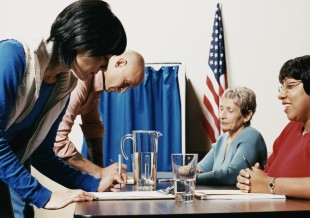Confusion over Texas’ voter photo identification requirement potentially discouraged as many as 9 percent of registered voters from going to the polls in the November 2014 elections in the Latino-majority U.S. Congressional District 23 (CD-23), according to a new study by Rice University’s Baker Institute for Public Policy and the University of Houston Hobby Center for Public Policy.
The study found that nearly 6 percent of the CD-23 nonvoters stated that the principal reason they did not vote was because they did not possess any of the seven forms of photo identification required by the state to cast a ballot in person. More than twice that many, nearly 13 percent, agreed that their lack of any one of the seven photo IDs was a reason they did not vote. However, when further queried about the different forms of photo identification actually in their possession, the survey revealed that a much lower proportion, slightly less than 3 percent, in fact lacked one of the seven forms of ID needed to vote in person. Still even fewer nonvoters (between 0.5 and 1 percent) both attributed their nonvoting to the lack of a photo ID and actually did not possess a valid photo ID.
“The study suggests the most significant impact of the Texas voter photo ID law on voter participation in CD-23 in November 2014 was to discourage turnout among registered voters who did indeed possessed an approved form of photo ID,” said Mark Jones, the Joseph D. Jamail Chair in Latin American Studies, professor of political science and fellow in political science at Rice’s Baker Institute. “Through some combination of misunderstanding, doubt or lack of knowledge, the voter believed that they did not possess the necessary photo identification.”
“One of the most striking findings of this study is that voters who did not vote actually did possess one of the valid forms of photo ID,” said Jim Granato, professor and director of the Hobby Center. “An important issue to be explored is not just the voter photo ID law itself, but the actual education and outreach efforts to ensure all eligible voters understand what form of photo ID may be used to vote.”
“If the voter photo ID law affected the outcome of any 2014 federal race in Texas, it would have been in CD-23,” Jones said.CD-23, which spans a large geographic area in west and south Texas, is a Latino majority district with Hispanics accounting for 65.8 percent of the district’s voting-age population and 58.5 percent of its registered voters. “Most observers consider CD-23 to be the only one of the state’s 36 U.S. House districts that is competitive for both Democratic and Republican Party candidates in the November general election,” Jones said. “If the voter photo ID law affected the outcome of any 2014 federal race in Texas, it would have been in CD-23.”
Other findings:
- Regarding the potential impact of the Texas voter photo ID law on the outcome of the 2014 election in CD-23, the findings suggest that the presence of the law kept far more supporters (four to five times as many) for then-freshman incumbent representative Pete Gallego, D-Alpine, away from the polls than those who supported the district’s current representative Will Hurd, R-San Antonio.
- Latino nonvoters were significantly more likely than Anglo nonvoters to strongly agree or agree that a lack of photo ID was a reason that they did not cast a ballot in the Nov. 4 contest.
Gallego lost to Hurd by 2,422 votes, 49.8 percent to 47.7 percent, in a district where 118,004 registered voters cast a ballot (115,429 in the CD-23 race) and 271,005 did not.
The study is based on a March 2015 telephone survey of 400 registered voters who did not vote in CD-23’s November 2014 election. It was conducted in English and Spanish.



Leave a Reply